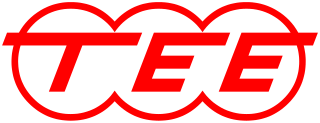
The Trans Europ Express, or Trans-Europe Express (TEE), was an international first-class railway service in western and central Europe that was founded in 1957 and ceased in 1995. At the height of its operations, in 1974, the TEE network comprised 45 trains, connecting 130 different cities, from Spain in the west to Austria in the east, and from Denmark to Southern Italy.
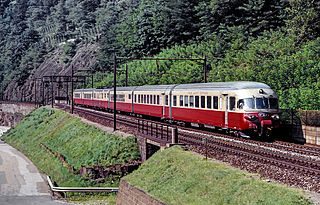
The RAe TEE II, later known as RABe EC, is a type of high-speed electric multiple unit trainset of the Swiss Federal Railways (SBB), which was used from the 1960s until the 1980s on several Trans Europ Express services. After conversion from first-class-only to two-class configuration, the trainsets continued in use on EuroCity or other services until 1999.

The Cisalpin was an express train that linked Paris-Gare de Lyon in Paris, France, with Milano Centrale in Milan, Italy. Introduced in 1961, it was operated by the SNCF, the Swiss Federal Railways (SBB-CFF-FFS) and the Italian State Railways (FS).

The Edelweiss was an international express train. For most of its existence, it linked the Netherlands with Switzerland, via Belgium, Luxembourg and France. Introduced in 1928, it was named after a mountain flower, the Edelweiss, which is associated with alpinism and the Alps, and regarded as a symbol of Switzerland.

Le Mistral, or the Mistral, was an express train between Paris and Nice in France. Introduced in 1950, it was operated by SNCF, and was regarded as the company's flagship train.
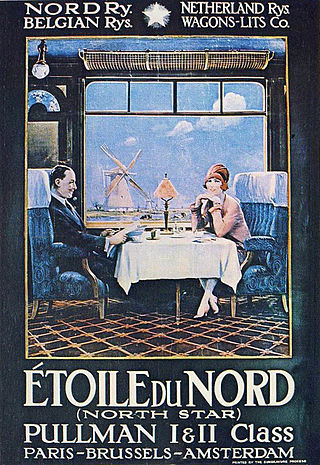
The Étoile du Nord was an international express train. It linked Paris Nord in Paris, France, with Brussels, Belgium, and, for most of its existence, also with Amsterdam CS in Amsterdam, the Netherlands. Its name meant literally "Star of the North", and alluded not only to its route heading north from Paris, but also to one of its original operators, the Chemin de Fer du Nord.

The word Mediolanum has been used to name three distinct international express trains that have run to and from Milano Centrale in Milan, Italy since 1957. The focus of these trains on the city now known as Milan reflects the fact that Mediolanum is the Latin word for ancient Milan.

The Catalan Talgo was an international express train that linked Geneva, Switzerland, with Barcelona, Spain from 1969 to 2010. It was named after the Spanish region Catalonia and the Talgo equipment it used. It was an extension and upgrading of a predecessor train, Le Catalan, a first-class-only French (SNCF) Rapide train that had been in operation since 1955 but running only between Geneva and the stations nearest the Spanish-French border, connecting with a second-class-only "autorail" trainset to and from Barcelona. The national railway network of Spain, Red Nacional de los Ferrocarriles Españoles (RENFE), was using Iberian gauge for all of its main lines, while those of France and Switzerland use standard gauge. As a result of this break-of-gauge, train journeys between Geneva and Barcelona consisted of two separate parts, with travelers having to change from a French to a Spanish train or vice versa at the border—at Portbou on southbound trains and at Cerbère on northbound trains. In 1968, this was resolved with the introduction of the Talgo III RD trainsets, which featured variable gauge wheelsets. At Portbou station, the wheel spacing of each passenger carriage was adjusted by a gauge changer for the difference in gauge, and passengers no longer had to change trains. After successful test runs, the Catalan was extended from Port Bou to Barcelona as a through train on 1 June 1969, becoming the Catalan Talgo and upgraded to a Trans Europ Express (TEE). Most other rail journeys through this border crossing continued to require a change of train at Cerbère station or at Port Bou, as most trains did not use Talgo III RD trainsets.

The Blauer Enzian is a named express train service that currently runs between Frankfurt in Germany and Klagenfurt in Austria. Introduced in 1951, it originally ran via the German North–South railway line between Hamburg and Munich. Labelled as an international Trans Europ Express (TEE) train, it also linked with Zell am See and Klagenfurt in Austria from 1969. Trains were operated by the Deutsche Bundesbahn (DB) and its Deutsche Bahn successor, from 1970 also by the Austrian Federal Railways (ÖBB).
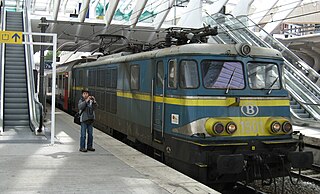
The Brabant was an express train that linked Gare du Nord in Paris, France, with Brussels-South in Brussels, Belgium. The train was named after the historical Duchy of Brabant of which Brussels was the capital.

The Saphir was an express train operated by the Deutsche Bundesbahn linking the port of Ostend with Dortmund as part of a link between London and the Ruhr. The name Saphir, German for sapphire, refers to the Belgian gemstone industry.

The Île de France was an international express train on the PBA route (Paris–Brussels–Amsterdam). The train was named after the French region surrounding Paris.

Le Lyonnais, or the Lyonnais, was an express train that linked Paris and Lyon in France. Introduced in 1968, it was operated by the Société Nationale des Chemins de fer français (SNCF). The train is named after the geographical area known as the Lyonnais, a historical (former) French province, whose name came from the city of Lyon.

The Jules Verne was an express train that linked Paris and Nantes in France. Operated by the Société Nationale des Chemins de fer français (SNCF), it was the last new Trans Europ Express (TEE) to be introduced, in 1980.

The Ticino was an express train that linked Milan in Italy, with Zürich, Switzerland and for some years even to Munich, Germany. The train was named after the Canton of Ticino in the south of Switzerland. Introduced in 1961, it was a first-class-only Trans Europ Express (TEE) service until 1974. Later, it was a EuroCity service.
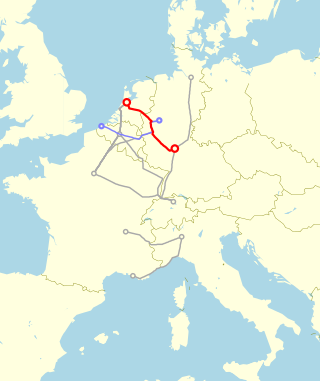
The Rhein–Main was an express train that linked Frankfurt am Main with Dortmund in Germany and later with Amsterdam in the Netherlands. The train was named after the two rivers, the Rhine and the Main, that join west of Frankfurt. For most of its life, it was a Trans Europ Express (TEE).

The Rembrandt was an express train that linked Amsterdam in the Netherlands, with Munich in Germany and later Chur in Switzerland. The train was named after the renowned Dutch painter Rembrandt. For its first 16 years it was a first-class-only Trans Europ Express, becoming a two-class InterCity in 1983 and finally a EuroCity in 1987.
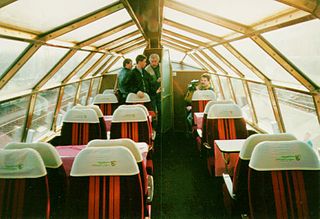
The Erasmus was an express train that linked The Hague, the Dutch seat of government, with Munich in Germany. The train was named for the Dutch Renaissance humanist Desiderius Erasmus.
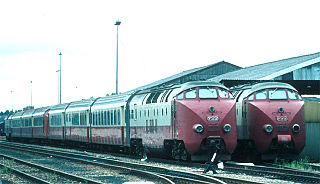
The SBB RAm TEE I and NS DE4 were a class of five 4-car diesel-electric trainsets ordered for Trans Europe Express (TEE) service. Two were ordered by the Swiss Federal Railways (SBB) and three by Nederlandse Spoorwegen (NS)

The SNCF CC 40100 was a French class of quad-voltage 4,340 kW (5,820 hp) electric locomotives. They were intended for high-performance passenger services on the Trans Europ Express (TEE) routes of the 1960s and 1970s. This non-stop international working required them to support the electrical standards of several networks. They are significant for combining three innovations in locomotive design: quad-voltage working, three-axle monomotor bogies and the new 'Nez Cassé' body style of French locomotives.





















